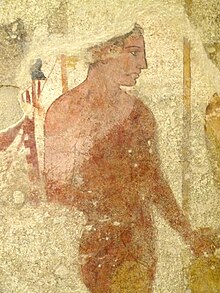Tomba Golini I
The Tomba Golini I (German: "Golini Grab I") is a painted Etruscan chamber grave. The grave was discovered in 1863 near Porano , a village near Orvieto in central Italy , together with Tomba Golini II . Both were Tombas after its discoverer Domenico Golini as Tombe Golini called.
The two Etruscan tombs date to the fourth century BC. Chr. Tomba Golini I is a bit older and belongs to the middle of the century. The paintings were removed from the wall in 1950 and brought to the Museo archeologico nazionale di Orvieto .
The tomb consists of a room that is divided in the middle into two halves by a partition made of tuff stone . On the walls of the burial chamber there are scenes from the life of the local upper class. The figures are labeled with the names and titles of the people. The servants are also called by name, which is otherwise rather unusual. The paintings on the left show the preparation of a banquet. Servants and cooks are depicted, as is a flute player who accompanies them musically. You can also see a meat magazine and an oven.
The banquet itself is depicted in the right part of the chamber, with the underworld gods Aita ( Hades ) and Phersipnai ( Persephone ) present. Another scene shows the dead man on a chariot as he drives into the underworld.
The grave belongs to the Leinie family. Five generations are mentioned in the grave. Titles are also mentioned, including the zilath mechl rasnal , which was one of the most important Etruscan offices.
literature
- Stephan Steingräber : Abundance of Life, Etruscan Wall Painting . Los Angeles 2006, ISBN 978-0-89236-865-5 , pp. 211-212.
Web links
Coordinates: 42 ° 42 ′ 4 " N , 12 ° 5 ′ 57.8" E

